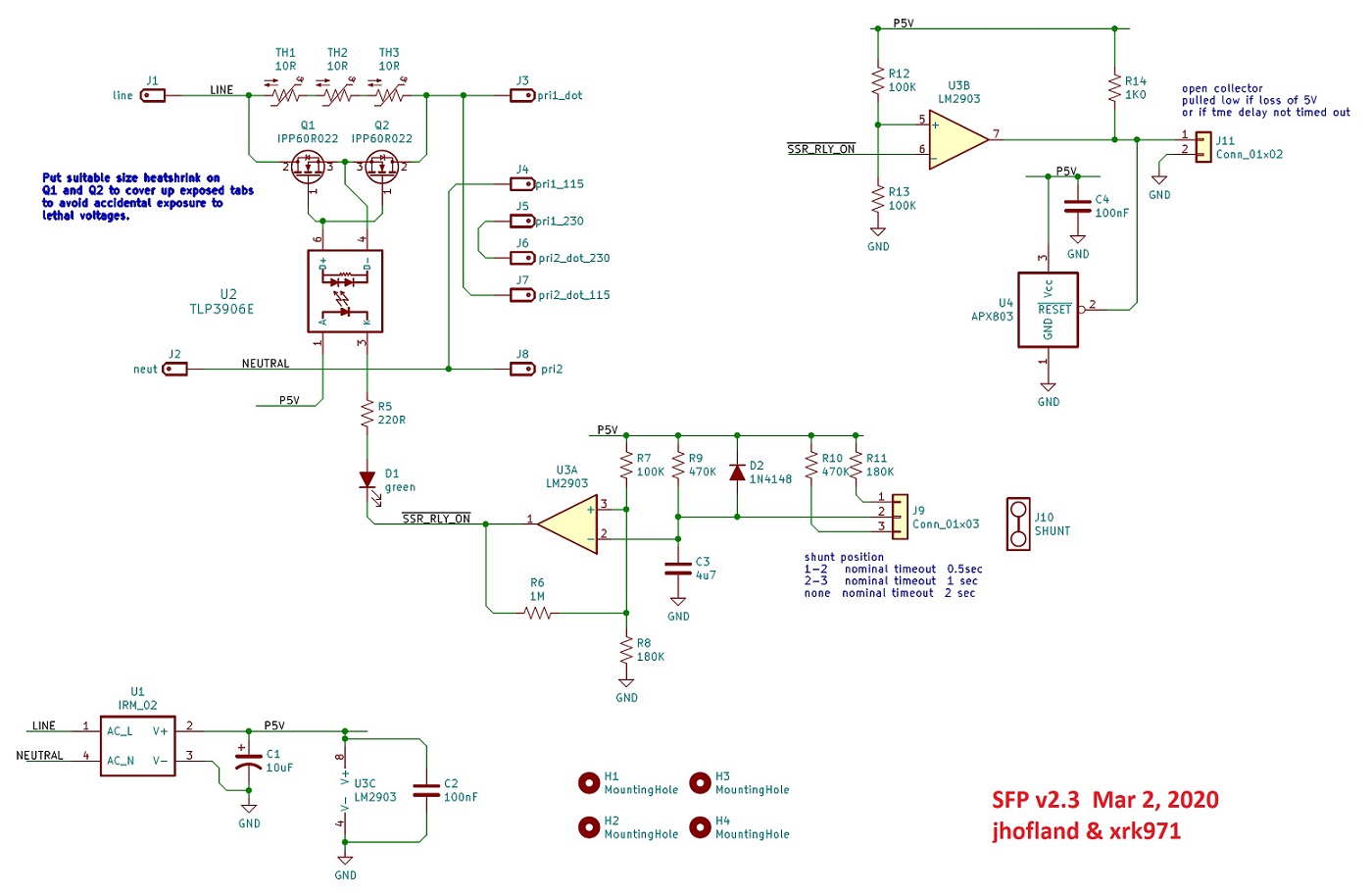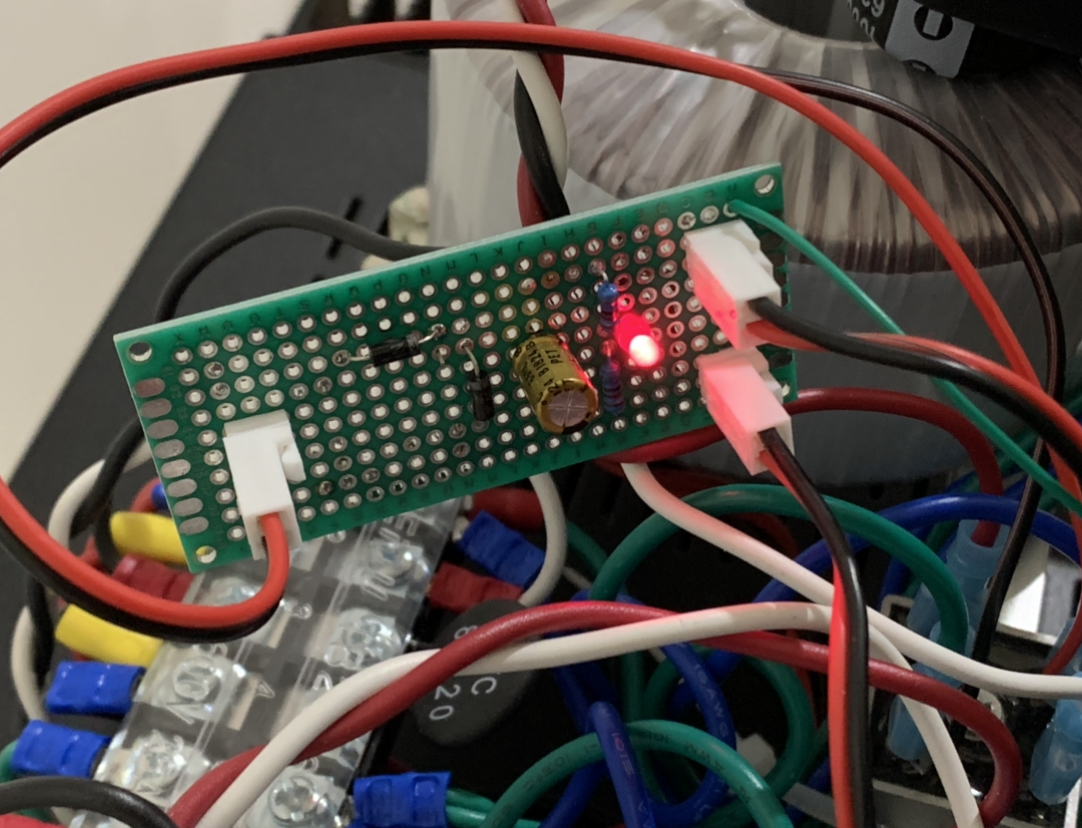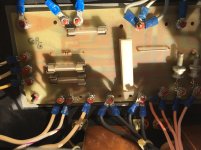I am not sure these types of soft starts are as great as they are promised.
Over the last 10+ years have used thermister based soft starts for my Krell clone (class A 60WPC) and my 50 WPC Class A Extrema, and actually a number of my other DIY amps. Whether you bypass the thermisters after 2 seconds or 8 seconds there is always a "boooooing" from the large power transformers (physical noise not from speakers) when the thermisters are bypassed. I tried a bunch of CL60s/ 80s etc.. alone, in series, 2 3 etc...
I do not know if its the thermisters not heating up or what as its hard to measure without a scope but it does not seem to be as soft as I thought it would be. Just fyi.
Over the last 10+ years have used thermister based soft starts for my Krell clone (class A 60WPC) and my 50 WPC Class A Extrema, and actually a number of my other DIY amps. Whether you bypass the thermisters after 2 seconds or 8 seconds there is always a "boooooing" from the large power transformers (physical noise not from speakers) when the thermisters are bypassed. I tried a bunch of CL60s/ 80s etc.. alone, in series, 2 3 etc...
I do not know if its the thermisters not heating up or what as its hard to measure without a scope but it does not seem to be as soft as I thought it would be. Just fyi.
Not sure what sound you mean in terms of the booing sound from the transformers? When I start my amp up with the SFP (50w SE Class A with 500VA transformer) I don’t hear any sounds.
Perhaps you are hearing mechanical hum - uses more in series to get the ohms up. Three CL60’s is 30ohms. That should be a very soft load for a transformer to let its power into. Three in series permanently is a lot of heat so this is why a MOSFET SSR makes sense. No heat and several volts regained.
Perhaps you are hearing mechanical hum - uses more in series to get the ohms up. Three CL60’s is 30ohms. That should be a very soft load for a transformer to let its power into. Three in series permanently is a lot of heat so this is why a MOSFET SSR makes sense. No heat and several volts regained.
For any Canadians build this, where do you order your parts? Mouser, Digikey, or anywhere else? We have a local Active Electronics store also. I entered a few of the part numbers in to the Mouser web site and they cost only pennies. I'm sure shipping will be more than the parts.
I ordered the board with the U2 and U4 parts already soldered on.
I ordered the board with the U2 and U4 parts already soldered on.
Another question about the inrush current limiters. They are not in stock anywhere. Is there a substitute? Ametherm SG314 is a 6A, 10 ohm, are those the only specs that matter. The dimensions are similar, I can't see that making a difference?
I use 8D-20 NTCs. Bag of 10 for about $8 on eBay. These are 8ohm and 6A I think. 0.5ohm when hot.
For example:
10pcs NTC 8D-20 Power NTC Thermistor surge current limiting 8 Ohm 6A 6Amp NEW 652042059609 | eBay
For example:
10pcs NTC 8D-20 Power NTC Thermistor surge current limiting 8 Ohm 6A 6Amp NEW 652042059609 | eBay
Anything from China to Canada takes about 10 weeks lately. That seller won't ship to Canada anyway. This the one I was thinking of ordering.I use 8D-20 NTCs. Bag of 10 for about $8 on eBay. These are 8ohm and 6A I think. 0.5ohm when hot.
For example:
10pcs NTC 8D-20 Power NTC Thermistor surge current limiting 8 Ohm 6A 6Amp NEW 652042059609 | eBay
SG314 Ametherm | Mouser Canada
AC mains connects to the two inputs on left J1 and J2 (Line and Neutral) and the trafos connect on the right J3/J4/J5/J6/J7/J8. Depending on your transformer and your mains voltage, you may need to connect the two primaries in series or parallel. The extra Faston tabs give this option for series connection. If you have dual trafos then parallel their inputs to the Line out and Neutral out pass through.
Last edited:
I figured it out and it is playing music. I can't really notice a delay or anything when it turns on, it doesn't ca-chunk when a hit the power switch now. It was not that bad before anyway. I don't have any of the jumper installed either.
Next project is the speaker protection boards.
Next project is the speaker protection boards.
Hi X,
...
Also what is connector J11 used for?
...
Regards,
Gary..
I can't spot a response to this question. What's the official answer?
Thanks

Sorry I missed this question earlier. J11 is an open collector logic output for controlling the quick shutdown of a SSR speaker protection board or mechanical relay controlled by a microcontroller or other logic device using "open collector" logic. This will allow the SFP to instantly disconnect the speakers from the amp output when the power is switched off at the SFP. This was meant as a way to prevent turn off thump.

Last edited:
Thought that something like that might be the case.
I've got some Gen 1 SSRs, so I had a thought that to achieve the same kind of function in an easy and cheap way would be to power the SSR by a low powered AC-DC converter rather than the amp's +ve rail.
Digikey has the linked unit (Aimtec AMEL5-24SVZ-W) for not much. So, my thinking runs along the lines of strap an AMEL5-24SVZ-W (datasheet here or something similar) down to hold it in place via nefarious means and locate it somewhere convenient. Then, feed its output to the SSR Gen 1 for its > +19 VDC supply.
The AMEL5-24SVZ-W would be fed the same mains supply feeding the amp in parallel, so that as soon as the power is switched off, then pretty quickly the SFP should drop out and isolate the output to the speakers.
My musing is that this would end up coming close to the same as an SSR Gen 2 but without needing to send the SSR Gen 1s to an early grave.
Bad idea? Or OK?
Constructive thoughts?
Thanks.
I've got some Gen 1 SSRs, so I had a thought that to achieve the same kind of function in an easy and cheap way would be to power the SSR by a low powered AC-DC converter rather than the amp's +ve rail.
Digikey has the linked unit (Aimtec AMEL5-24SVZ-W) for not much. So, my thinking runs along the lines of strap an AMEL5-24SVZ-W (datasheet here or something similar) down to hold it in place via nefarious means and locate it somewhere convenient. Then, feed its output to the SSR Gen 1 for its > +19 VDC supply.
The AMEL5-24SVZ-W would be fed the same mains supply feeding the amp in parallel, so that as soon as the power is switched off, then pretty quickly the SFP should drop out and isolate the output to the speakers.
My musing is that this would end up coming close to the same as an SSR Gen 2 but without needing to send the SSR Gen 1s to an early grave.
Bad idea? Or OK?
Constructive thoughts?
Thanks.
Last edited:
Hi Astromo,
You could use your AC-DC converter, but making one out of two 1N400x diodes, a 10uF cap, a resistor and LED would be much cheaper and works very well to prevent turn off thump. I tested it out here:
Ready-to-Run (RTR) SSR DC Speaker Protection and Delay GB
I am in fact, using it everyday on my FH9HVX,
It's maybe $1 worth of parts if even that.

A half wave bridge connected to your amp's secondary to make DC that charges a small cap which then powers the SSR protection circuit. Once the mains is removed, the AC secondaries collapses instantly and the 10uF smoothing cap runs out in under 100ms, thereby shutting off the SSR. The LED and resistor are optional and provide indication.
You could use your AC-DC converter, but making one out of two 1N400x diodes, a 10uF cap, a resistor and LED would be much cheaper and works very well to prevent turn off thump. I tested it out here:
Ready-to-Run (RTR) SSR DC Speaker Protection and Delay GB
I am in fact, using it everyday on my FH9HVX,
It's maybe $1 worth of parts if even that.
A half wave bridge connected to your amp's secondary to make DC that charges a small cap which then powers the SSR protection circuit. Once the mains is removed, the AC secondaries collapses instantly and the 10uF smoothing cap runs out in under 100ms, thereby shutting off the SSR. The LED and resistor are optional and provide indication.
Sweet as.
I missed that. I'll have to have a chat with the regimental clerk about keeping me up to date with the latest dispatches from the trenches. Most disappointing.
with the regimental clerk about keeping me up to date with the latest dispatches from the trenches. Most disappointing.
Thanks for the intel. I reckon I'll put that to use..
I missed that. I'll have to have a chat
 with the regimental clerk about keeping me up to date with the latest dispatches from the trenches. Most disappointing.
with the regimental clerk about keeping me up to date with the latest dispatches from the trenches. Most disappointing.Thanks for the intel. I reckon I'll put that to use..

On the 2gen SSR we provide a fancy helper board to do this but actually provide the open collector logic signal vs shutting off the power supply.
Although I think that the low capacitance AC/DC power supply trick works like a miracle on gen1 or Gen2.
Although I think that the low capacitance AC/DC power supply trick works like a miracle on gen1 or Gen2.
KISS man ... way to go.
From my engineering background (not electrical), I've been told that a good engineer is someone who can make an idea work for 10c that would cost someone else a buck. Accounting for inflation, you're on the money.
I'm sold.. 😎
From my engineering background (not electrical), I've been told that a good engineer is someone who can make an idea work for 10c that would cost someone else a buck. Accounting for inflation, you're on the money.
I'm sold.. 😎
Hi folks, we found a much more cost effective MOSFET to use as the SSR here. This one is about $5 vs $12.50 for the last one. The new one is rated 650v, 44A, and 67mOhm RDson.
https://www.mouser.com/ProductDetai...I1px%2BYuwuaZKDDXAVpY0IGGVx4nLsFFbw2cmIc8hw==
https://www.mouser.com/ProductDetai...I1px%2BYuwuaZKDDXAVpY0IGGVx4nLsFFbw2cmIc8hw==
- Home
- Group Buys
- Soft as a Feather Pillow (SFP) SSR Soft Start Circuit GB
